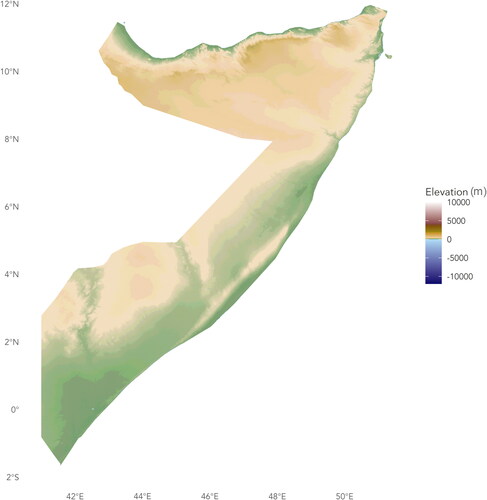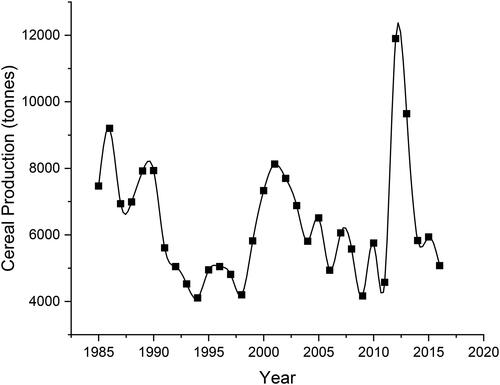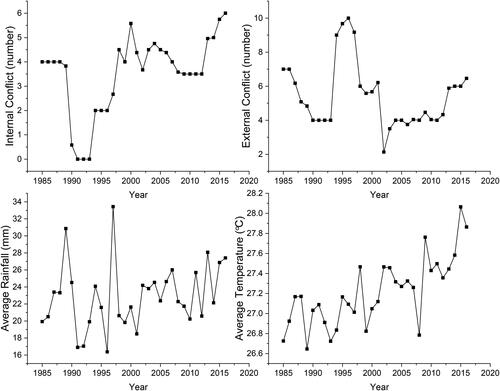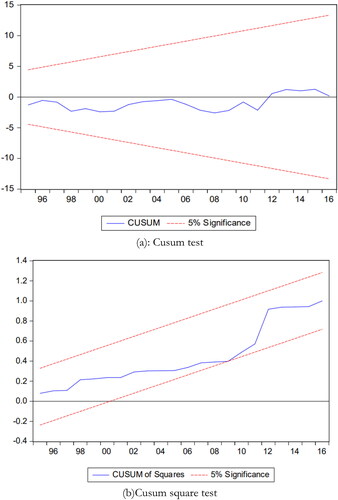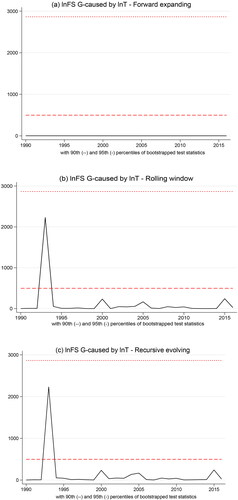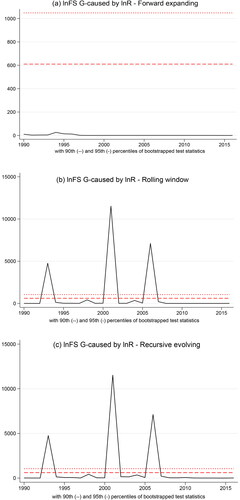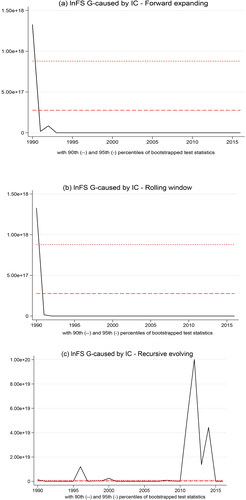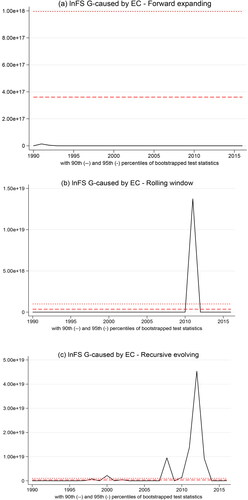 ?Mathematical formulae have been encoded as MathML and are displayed in this HTML version using MathJax in order to improve their display. Uncheck the box to turn MathJax off. This feature requires Javascript. Click on a formula to zoom.
?Mathematical formulae have been encoded as MathML and are displayed in this HTML version using MathJax in order to improve their display. Uncheck the box to turn MathJax off. This feature requires Javascript. Click on a formula to zoom.Abstract
Global food insecurity is projected to increase in distant years, which is challenging to achieving Sustainable Development Goal (SDG) 2, viz. zero hunger in 2030. However, recent reports and studies suggest that climate variabilities and conflicts are the main hurdles developing and less developed nations face to overcome food insecurity and hunger. This undertaking assesses the effect of climate change and conflicts (external and internal conflicts) on food security in Somalia. To this end, the autoregressive distributed lag (ARDL) model, and time-varying Granger causality are utilized with annual data spanning 1985–2016. The empirical results show that average temperature and internal conflicts significantly hamper food security whereas rainfall and external conflicts are statistically insignificant in the long run. Besides, the time-varying Granger causality reveals that annual rainfall and temperature uniformly cause food security in two episodes (i.e. 1990–1992 and 2011–2012). Notably, Somalia experienced severe droughts which later led to a famine in 1992 and 2011. Similarly, both internal and external conflicts Granger cause food security in two similar episodes (i.e. 1990–1991 and 2010–2015). Our study underscores the importance of de-escalating the prolonged conflicts in Somalia and the need for designing policies that improve water availability to mitigate the adverse effects of climate change.
Reviewing Editor:
1. Introduction
The elimination of hunger, food insecurity and malnutrition are some of the 21st century’s daunting challenges. Different goals were set up by the United Nations to eradicate hunger and make food accessible to all people, such as the Millennium Development Goals (MDGs, 2000–2015) and Sustainable Development Goals (SDGs, 2015–2030). Thus, a tremendous achievement has been reached in this goal. People suffering from undernourishment are estimated at 690 million in 2019, reducing by more than 260 million over the last decade, and 320 million since 1990–1992. However, the number of people with food insecurity has increased substantially in the last decades, with 60 million people affected by hunger. Undernourishment and severe food insecurity continue to rise mostly in Africa and South America but are stable in Asia (FAO, Citation2020; Dorosh et al., Citation2016). Hence, if this trend continues, the number of food-insecure will reach 840 million in 2030. However, this shows that the world is not yet on the right track to achieving the second target of global SDGs by eradicating hunger and achieving food security by 2030 (FAO, Citation2020).
Current reports of FAO (Citation2018, Citation2020) suggest that climate variabilities and conflicts are the main hurdles undermining efforts to eliminate hunger, malnutrition and chronic food insecurity. The food insecurity induced by conflicts is immediate and sustains for a long time. Conflicts often stall the ability of production, trade and access to food (United Nations, Citation1993). Nevertheless, several studies validate these arguments that conflicts undermine food security and increase undernourishment (Kinda & Badolo, Citation2019; Ujunwa et al., Citation2019; D’Souza & Jolliffe, Citation2013). In addition to this, empirical studies emphasized that places that are prone to conflicts are more vulnerable to facing food insecurity than stable ones. Countries with fragile economies and weak institutions are potentially more vulnerable to food insecurity than others (Mitchell et al., Citation2015). On the other side, food security encompasses four dimensions namely food availability, food system, food safety and food accessibility. Climate variabilities threaten all these four dimensions by influencing livelihoods, food production and distribution, human health and changes in market flow and purchasing power (FAO, Citation2008; Buhaug et al., Citation2015; Ray et al., Citation2019; Abdi et al., Citation2023). The empirical examinations show that climate variability hampers food security, and food availability per capita, thus increasing the percentage of the undernourished population (Kinda & Badolo, Citation2019). More specifically, climate anomalies especially rainfall variability impedes food security, whereas an increase in precipitation enhances it (Rosenzweig & Parry, Citation1994; Buhaug et al., Citation2015; Akbar et al., Citation2018). Therefore, the population already vulnerable and exposed to hunger is more affected by climate change and conflicts.
Somalia is one of the 22 countries with protracted crises in the world. Conflicts and natural disasters – mainly droughts and floods perpetuated Somalia’s protracted crises. Consequently, the most notable detrimental impact has been its effect on Somali households’ resilience and well-being – by rising food insecurity, deepening poverty and losing assets and livelihoods (FAO, Citation2011–2015). Food insecurity is prevalent among displaced populations and poor rural populations whose household sources of food and income are impacted by natural disasters. Currently, 3.5 million people are experiencing food insecurity situation in Somalia. This number is projected to rise in the next distant years due to poor expected rainfall in the autumn and spring seasons (Famine Early Warning Systems Network, Citation2020).
Climate change causes food insecurity through its adverse effects on agricultural production and food availability (see, Badolo & Kinda, Citation2015; Carandang et al., Citation2015; Firdaus et al., Citation2020; Kipkemboi et al., Citation2020; Lenderking et al., Citation2020). By using a panel of 71 developing countries from 1960 to 2008, Ferrand and Kinda (Citation2014) reported that climate change impedes food security in developing nations. The empirical finding revealed that the effect is more pronounced in sub-Saharan Africa due to the outbreak of recurrent civil wars in these countries and their vulnerability to world food price fluctuations. In the same vein, Kinda and Badolo (Citation2019) found that climate variability (measured by rainfall variability) does not only hamper food security and food availability but also raises the percentage of the undernourished population. These findings are supported by Firdaus et al. (Citation2020) who found similar results using data from Malaysia. Climate change poses major significant threats to food security in Africa due to the significant population growth and stagnation in food production (Birhanu et al., Citation2011; Mahrous, Citation2019; Becker & Elliot, Citation2022; Warsame & Daror, Citation2024). Moreover, Edoja et al. (Citation2016) found a significant negative short-run relationship between CO2 emissions and food security in Nigeria using annual time series spanning 1961–2010. Specifically, the results from variance decomposition revealed that 22–23% of changes in agricultural productivity and food security are caused by variations in CO2 emission.
In contrast, a plethora of studies relate food insecurity, hunger and malnutrition to conflicts (Ujunwa et al., Citation2019). For instance, Kinda and Badolo (Citation2019) reported that civil conflicts impede food security in 71 developing and least-developed countries. Thus, the repercussions of climate change are larger in countries that are vulnerable to conflicts. In the same vein, armed conflicts undermine food security in West African countries (Ujunwa et al., Citation2019). A single-country study performed in Afghanistan revealed that conflicts inhibit food security in Afghanistan using household surveys and geo-coded data (D’Souza & Jolliffe, Citation2013). In a follow-up study, Dabalen and Paul (Citation2014) evaluated the effect of conflicts on dietary diversity in Côte d’Ivoire using household data. They reported that households who live in worst-hit conflict areas encounter lower dietary diversity and lower food security. Thus, conflict undermines food security and dietary diversity.
The critical appraisal of the literature indicates that climate change, conflicts and food security nexus are limited in least developed countries. This can be attributed to data availability over a long period and complex dimensions of measuring food security. Notably, there are no ample empirical studies conducted in the context of Somalia. Hence, examining this issue using historical time series data and econometric models to assess the impact of climate change and conflicts on food security will provide empirical evidence for designing appropriate policies to tackle the food security issues in Somalia. Against this backdrop, this undertaking is the first study conducted in Somalia that empirically investigates the impact of climate change (i.e. measured rainfall and temperature) and conflicts (i.e. internal and external conflicts) on food security. We contribute to a new dimension that incorporates both climate and conflicts within the same model to ascertain the veracity of socio-political and agricultural effects on food security in the context of a prone-conflict country. Moreover, existing empirical studies on the climate change-conflict-food security nexus have utilized standard Granger causality models (Kinda & Badolo, Citation2019; Becker & Elliot, Citation2022). This study utilizes time-varying Granger causality to find the specific episode of drivers that underpin food security. Time-varying Granger causality could handle instabilities resulting from structural breaks and regime shifts lacking in the standard VAR models and other causality tests. Hence, this study assesses the impact of climate change and conflicts on food security in Somalia using time-varying Granger causality, viz. based on the null hypothesis (H0) that:
Climate change and conflicts do not have an adverse effect on food security.
2. Study area
Somalia, which emerged as a sovereign nation in 1960 after the unification of a former British protectorate and an Italian colony, experienced a state of lawlessness subsequent to the ousting of President Siad Barre’s military regime in 1991 (see ). The majority of livelihoods in Somalia are driven by rainfed agriculture. Climate change impedes agriculture production which in turn leads to less domestic production (Warsame et al., Citation2021; Warsame & Sarkodie, Citation2022). Besides, conflicts also undermine agriculture production by forcing people to flee from their residents and farms owing to insecurities. As a result of this, widespread hunger, malnutrition and enormous local immigration occur. The climate impact is exacerbated by conflicts which sometimes convert into famine. Conflicts and droughts interact and are considered causal mechanisms that are inseparable (Clover, Citation2003). A classic example of this is the famine that occurred in Somalia in 1992 and 2011. As a result of the 1991–1992 and 2010–2011 crises, 200,000 and 280,000 people, respectively, have died. Both of these two famines homogenously commenced from climate shocks, viz. rainfall failure – which affected agriculture production in Somalia. Additionally, conflicts fuelled the adverse impact of the disaster which threatened livelihoods and disturbed food aid to the most in-need people (Maxwell & Fitzpatrick, Citation2012).
Byrnes and Bumb (Citation1998) reported that cereals represent 60–70% of the average calorie per capita consumption required. Therefore, it is often used as a proxy for food security. Previous studies have utilized it as a measurement of food security (Ujunwa et al., Citation2019; Becker & Elliot, Citation2022). shows cereal production over the period 1985–2016 in Somalia with irregular components. Cereal production decreased from 9202 in 1986 to 4104 tons in 1994. This substantial reduction could be attributed to the civil wars that broke out in 1991 and the droughts which later led to famine in 1992–1993. It recovered in 2001 before it plummeted in subsequent years. Notably, the peak cereal output was recorded in 2012 with 11,900 tons from 4572 tons in 2011. Since then, cereal output has been decreasing.
3. Data and methods
3.1. Data
This study utilizes annual time series data from 1985 to 2016, by sourcing from the World Bank, International Country Guide Risk (ICRG) and FAO to analyze the dynamic impacts of climate change and conflicts on food security in Somalia. We adopt total cereal availability as a proxy of food security – from whence it is used as the dependent variable (Ujunwa et al., Citation2019; Becker & Elliot, Citation2022). Despite food security being considered a complicated term that has several dimensions, most previous studies used food availability. Thus, total cereal availability plays a paramount role in ensuring food availability, especially in times of crisis. Average rainfall, average temperature, internal conflict and external conflict are employed as explanatory variables. Internal conflict is an assessment rating that contains three components: (a) civil war/coup threat, (b) terrorism/political violence and (c) civil disorder. The risk rating assigned is the sum of three subcomponents, each with a maximum score of four points and a minimum score of 0. A score of 4 points equates to Very Low Risk and a score of 0 to Very High Risk. External conflict is an assessment rating that contains three components: (a) war (b) cross-border conflict, and (c) foreign pressures. The risk rating assigned is the sum of three subcomponents, each with a maximum score of four points and a minimum score of 0. A score of 4 points equates to Very Low Risk and a score of 0 to Very High Risk. We converted all the variables into a natural logarithm, except internal and external conflicts, to reduce the variance while interpreting coefficients in an elasticity form. presents the description and sources of the data, whereas depicts the trends of the sampled independent variables.
Table 1. Variable descriptions and sources.
3.2. Methods
To assess the impact of internal conflict, external conflict, average rainfall and average temperature on food security, the following model is specified – by utilizing the previous studies of (Ujunwa et al., Citation2019; Becker & Elliot, Citation2022) – as follows:
(1)
(1)
where ,
,
,
and
representfood security, average rainfall, temperature, internal conflict and external conflict respectively whereas
is the disturbance term.
The bound test is employed to discover the short- and long-run relationship between conflicts, climate change, and food security (Pesaran et al., Citation2001). We selected the autoregressive distributed lag (ARDL) method over other cointegration methods on the premise of producing efficient and unbiased results using a small sample size. Our sampled variables exhibit a mixed order of integration – level I (0) and the first difference I (1), requiring the bounds test estimation. Moreover, the selected technique could estimate both the short- and long-run coefficients simultaneously. Utilizing EquationEquation (1)(1)
(1) , we specify the ARDL result of the long- and short-run coefficient elasticities as follows:
(2)
(2)
where and
, …,
are the intercept and short-run coefficient of variables, respectively.
and
representthe long-run coefficients of the regressors’ and first difference operators, respectively. a and b are the lag lengths of dependent and independent variables, respectively. ECT is the error correction term that indicates the speed of adjustment.
3.2.1. Time-varying causality
After determining the presence of cointegration among the variables in the long run, we further used the time-varying Granger causality to assess the causal association among climate change, conflicts, and food security in Somalia. Time-varying Granger causality outperforms standard Granger causality tests in several aspects. For instance, the time-varying Granger causality could handle instabilities resulting from structural breaks and regime shifts contrary to the standard VAR models and other causality tests. Second, the time-varying granger is better than the standard methods on the premise that it produces significant specific years of the cause-effect parameters. It has three test procedures including recursive evolving, rolling window and forward-expanding (Baum et al., Citation2022). We estimated all three procedure tests of the time-varying Granger causality using the corrective bootstrap algorithm process.
4. Results and discussions
4.1. Summary statistics
Summary statistics is important for assessing the main characteristics of the data such as mean, median, maximum and normality of data. The mean of food security, average rainfall and average temperature are 12.67, 3.11 and 3.3 respectively (). Food security, average rainfall and average temperature have the highest maximum values of 13.39, 3.5 and 3.3 respectively. The Jarque–Bera test indicates that most of the variables are normally and identically distributed. presents the correlation between the variables. Average temperature, internal conflicts and external conflicts have a negative correlation with food security, whereas average rainfall and food security are positively correlated. Additionally, the average temperature has a positive association with external conflict and average rainfall but has an adverse correlation with internal conflict. Similarly, rainfall is negatively related to internal conflict. More importantly, the independent variables do not exhibit perfect collinearity.
Table 2. Descriptive statistics.
4.2. Unit root test
One of the main prerequisite steps in time series data analysis is testing the order of integration of variables. In this study, we utilized augmented Dickey–Fuller (ADF) and Philips–Perron (PP) tests to achieve this objective. We find that food security, average rainfall and temperature are stationary at level [I (0)] and the first difference [I (1)], but internal and external conflicts are integrated at I (0) as shown in . All the interested parameters are stationary at the first order I (1), hence, we proceeded to estimate the ARDL bound test.
Table 3. Result of unit root tests.
Subsequently, we investigated the existence of the long-run cointegration of the variables after assessing the unit root. The bounds test is used to determine the long-run cointegration as reported in . The results find that the F-bound test statistics (3.7) is above the upper bound critical value (3.49) at a p value < 0.05. This confirms a long-run cointegration between food security, average rainfall, average temperature, and internal and external conflicts. Notably, we utilized a general-to-specific approach to determine the optimal lag length.
Table 4. The F-bounds test.
After confirming the long-run cointegration among the interested parameters, we examined the long-run coefficient elasticities of the sampled parameters. The long-run results displayed in show that the average temperature and internal conflict significantly impede food security in Somalia. Interpretively, a 1% increase in average temperature reduces food security by about 51% in the long run. Similarly, internal conflict hampers food security in Somalia. This implies that if civil conflicts go up by 1 unit, food security declines by 0.17% in the long run. An increase in rainfall by1% induces the rise of food security by about 0.17% (p value > 0.05, even though statistically insignificant) in the long run. In the same vein, external conflict is insignificant in the long run.
Table 5. Long-run coefficient elasticities.
The short-run dynamic effects reported in show that average temperature, external conflict, and internal conflict dampen food security in the short run despite their statistical insignificance. On the contrary, average rainfall induces food security by ∼0.68%for a 1% rise in average rainfall in the short run. More importantly, the ECT has a statistically significant negative coefficient, which implies that the model converges in the long run. Any shock deviation occurs in food security is corrected 84% by the sampled independent variables. For robustness, our estimated results passed all the several diagnostic tests presented in namely the reset test (for misspecification), adjusted R-square (for error metrics), serial correlation, Jarque-Bera (for normality), and heteroskedasticity. Model stability tests performed using Cusum and Cusum square tests in reveal no structural break in the estimated model.
Table 6. Short-run dynamic effect and diagnostic test.
4.3. Robust analysis
To verify the results of the ARDL bound test, Johansen and Juselius (J&J) cointegration method was employed to examine the long-run relationship between food security and the interested explanatory variables. Hence, the result of J&J cointegration reported in finds that at least, one cointegrating vector exists among the variables as indicated by Trace and Maximum Eigenvalue tests. In other words, there is a long-run cointegration between food security, average temperature, average rainfall, internal conflicts and external conflicts.
4.4. Time-varying Granger causality
Time-varying Granger causality indicates the causality between food security and the interested regressors. To validate the significance of causality among the interested parameters, we employed the 90th and 95th percentiles of the empirical distribution. All the test statistics of the forward expanding, recursive evolving and rolling window are reported in . Two variables cause each other when the sequence of the statistics is greater than the 90th and 95th percentiles. Causality running from average temperature to food security is presented in Panel (a). All three algorithms – forward, recursive and rolling – show various causality episodes and non-causality periods. For the forward, average temperature causes food security from 1990 to 1992. For the rolling window, two episodes of causality (1990–1992 and 2010–2012) from average temperature to food security are detected. For the recursive evolving algorithm, four episodes of causality (1990–1992; 1993–1996; 1996–1997; and 2010–2015) are observed. The results of the rolling and recursive from 2010 to 2012 and 2010–2015, respectively, are the peak periods of causality running from average temperature to food security. Further, the time-varying Granger causality running from average rainfall to food security is presented in . There is one episode of causality from average rainfall to food security (1990–1992) in the forward result. For the rolling window, two episodes of causalities (2005; and 2006–2009) are identified from average rainfall to food security. But there are five episodes of causality in the recursive evolving result (1990–1993, 1993–1995, 1996–1997, 2002–2010 and 2011–2013). The peak causality happened in the 1993–1995 period. Average rainfall and temperature episodes of causalities are almost similar. For instance, both of them cause food security in the 1990–1992 and 2011–2012 episodes. It is notable that Somalia experienced severe droughts which later led to a famine in both 1992 and 2011. A rise in temperature results in rainfall variability. Hence, three consecutive seasons of rain failures induced the drought which caused the famine in 2011. The famine affected 3.1 million people in South and Central Somalia and around a half million children became malnourished in 2011 (Maxwell & Fitzpatrick, Citation2012). It is estimated that 250,000 people - half of whom were children – died in 2011 as a result of the famine (International Rescue Committee, Citation2022).
Figure 5. (a) Date stamping causality from temperature to food security. (b) Date stamping causality from rainfall to food security. (c) Date stamping causality from internal conflict to food security. (d) Date stamping causality from external conflict to food security.
Besides, causality running from internal conflict to food security is reported in Panel (c). Both forward expanding and rolling window algorithms reveal that internal conflict causes food security in Somalia from 1990 to 1991, whereas the rest of the periods are insignificant. Notably, three causality episodes (1995–1996; 2000; and 2010–2015) with a peak episode in 2010–2015 are reported in the recursive evolving algorithm. Moreover, causality running from external conflict to food security is depicted in Panel (d). The forward-expanding algorithm reveals that external conflict does not cause food security in Somalia in all sampled periods. But for the rolling window result, there is only one episode of causality (2010–2012) from external conflict to food security. Three episodes of causalities (2000, 2007–2009 and 2010–2014) running from external conflict to food security are identified in the recursive evolving result. A striking result is that both internal and external conflicts Granger cause food security in two similar episodes (1990–1991 and 2010–2015). This could be attributed to the period the Somali military government was ousted from power in 1991 when the civil wars, conflicts, and violence were at their peak. A large part of the famine that occurred in 1992 is partly attributed to the civil war and disorder that occurred before that year. Similarly, civil wars and skyrocketing food prices are attributed to the famine in 2011 besides the drought (Maxwell & Fitzpatrick, Citation2012). Hence, our result sheds light on how conflicts (i.e. external and internal) hamper food security in Somalia.
4.5. Discussion
Rainfall is of paramount importance to food security. It is observed that average rainfall plays a crucial role in enhancing food security in the short run but not in the long run. However, our results of positive rainfall effect on food security are in line with previous studies such as Kinda and Badolo (Citation2019), and Mahrous (Citation2019). The inhibitory impacts of conflicts on food security are contrary to previous results (see Souza & Jolliffe, 2013; Dabalen & Paul, Citation2014; Ujunwa et al., Citation2019). Rainfall induces a rise in food security that can be attributed to several factors. First, precipitation is the main source of irrigation for agricultural production in developing and least-developed nations, including Somalia. More specifically, in the context of Somalia, agriculture is an essential source of food, income and employment opportunities to meet livelihoods in households. Domestic production covers 50% of the population’s demand for cereal, however, the irrigation system of the country is not diversified (FAO, 2012). The main source of water for irrigation is precipitation, implying that agricultural cultivation in the nation is confined to specific seasons. Spring (during the April–June period) and autumn (during the October–December period) are the two main seasons of agricultural cultivation in Somalia due to the availability of irrigation water from precipitation. Sixty percent of annual cereal output is produced during the spring season in South and Central Somalia (the dominant agriculture production area) (GIEWS, Citation2020). A high rainfall pattern means high agricultural cultivation and harvesting, especially in the short run. In contrast, missing one of the two or both seasons leads to an acute shortage of domestic production, which in turn affects the livelihood of many who are mainly dependent on the agriculture sector for a living. Second, rainfall is not only important to agriculture cultivation but also to livestock production (i.e. the livelihoods of pastoral households are dependent on it). Half of the pastoralists’ annual income is generated from the sales of livestock; however, livestock products including milk also serve as a secondary source of income. Rainfall enhances the growth of fodders and crops eaten by the herds and also serves as the main source of drinking water. Hence, precipitation is important to the sustainability and growth of livestock production and its effect on food security.
We further observed that a rise in average temperature induces food insecurity, hunger and malnutrition. This result is in line with previous studies conducted in Somalia which concluded that a rise in temperature undermines crop production (Warsame et al., Citation2021); maize production (Warsame, Sheik-Ali, Barre, et al., Citation2022); Sorghum production (Warsame, Sheik-Ali, Barre, et al., Citation2022; Warsame, Sheik-Ali, Hassan, et al., 2022; Warsame, Sheik-Ali, Jama, et al., Citation2022); and livestock production (Warsame, Sheik-Ali, Hassan, et al., 2022). The outputs of these crops and livestock play a significant role in covering domestic food needs for the Somali population. Several other studies support our results. For instance, Becker and Elliot (Citation2022) observed that climate change – temperature – impedes food security in a sample of 15 African countries. A similar finding was observed by Ani et al. (Citation2022) in Nigeria using both quantitative and qualitative data. A rise in temperature affects food security by reducing precipitation. In addition, hot weather creates a conducive environment for fungus and mold to grow, which threatens food security by impeding both pre-harvesting and post-harvesting (Wielogorska et al., Citation2019).
The adverse effect of internal conflicts on food security in Somalia could be adjusted for several reasons. First, conflicts such as wars force millions of people to flee from their homes and abandon their livelihoods – which are either dependent on livestock rearing or crop cultivation. Consequently, food production declines and food prices spike – which will ultimately lead to hunger and malnutrition. Second, conflicts destroy infrastructure, institutions, and social cohesion, and ultimately undermine investments and food production. Conflicts do not only impede food production directly but also disturb food aid distribution to people in dire need during the period of crisis. A prime example of this is the 2011 famine that hit Somalia due to droughts in 2010–2011, and the sacking of aid distributors from territories controlled by Islamists (Maxwell & Fitzpatrick, Citation2012). Thus, Somalia experienced a famine caused by droughts but chiefly aided by conflicts, hence, affecting food security.
5. Conclusion and policy implications
This study empirically examines the effect of rainfall, temperature, internal conflict, and external conflict on food security for the period 1985–2016. Using the ARDL bounds test, the study confirms a stable long-run association between the variables under investigation. Furthermore, the empirical findings show an increase in rainfall enhances food security in Somalia both in the short- and long run, even though; it is statistically insignificant in the long run. Rises in average temperature and internal conflict have unfavorable effects on food security in Somalia and both undermine food security in the long run. However, external conflict is statistically insignificant both in the short- and long-run. The presence of long-run cointegration between food security and the independent variables is confirmed using the Johansen cointegration method.
The results of time-varying Granger Causality – forward, recursive and rolling – show various causality episodes and non-causality periods. For the forward, average temperature granger causes food security from 1990 to 1992. For the rolling window, two episodes of causality (1990–1992 and 2010–2012) are detected. For the recursive evolving, four episodes of causality (1990–1992, 1993–1996, 1996–1997 and 2010–2015) are observed. Further, the time-varying Granger causality running from average rainfall to food security reveals one episode of causality (1990–1992) in the forward result. For the rolling window, two episodes of causalities (2005; and 2006–2009) are identified from average rainfall to food security. But there are five episodes of causality in the recursive evolving result (1990–1993, 1993–1995, 1996–1997, 2002–2010 and 2011–2013). Besides, the forward expanding and rolling window reveals that internal conflict causes food security in Somalia in 1990–1991 whereas the rest of the periods are insignificant. However, there are three causality episodes (1995–1996, 2000 and 2010–2015) in the recursive evolving result. Besides, only one episode of causality (2010–2012) from external conflict to food security is observed in the rolling window. Three episodes of causalities (2000, 2007–2009 and 2010–2014) running from external conflict to food security are identified in the recursive evolving result.
To alleviate food insecurity in Somalia, our empirical findings offer some policies that can be pursued. Among other policy recommendations, the study emphasizes the importance of ending the prolonged internal conflicts in Somalia – owing to its major role in accelerating and significantly contributing to hunger and food insecurity in Somalia. A striking result of the study is that internal conflicts impede food security while external conflicts do not. Civil wars, terrorism, political violence and civil disorder undermine domestic production, impede investments in key economic sectors, exert rural-urban migration and increase the costs of production. Notably, all these factors will directly or indirectly affect the food security situation. Eliminating the internal conflict should be prioritized because of its adverse impact on food security. Further, a rise in temperature is more pronounced in affecting food security than conflicts. Climate resilient policies such as developing resilient crops to temperature could be implemented. The study suggests the need for designing policies that improve water availability, and food production while mitigating the adverse effects of climate change. Given the lack of investment in agriculture in Somalia, policymakers could enhance financial inclusiveness by strengthening and making small-scale loans to farmers.
The limitation of the study is evident in its country-specific assessment, i.e. focusing only on Somalia. Thus, future studies could examine the nexus between conflicts, climate change, and food security nexus in a panel of countries using the latest dataset.
Ethical approval
Not applicable.
Consent to participate
Not applicable.
Consent to publish
Not applicable.
Disclosure statement
The authors declare that they have no conflicts of interest.
Data availability statement
Data can be found at this link: https://www.fao.org/faostat/en/#data/QCLhttps://climateknowledgeportal.worldbank.org/country/somalia/climate-data-historical
Additional information
Funding
Notes on contributors

Abdimalik Ali Warsame
Abdimalik Ali Warsame is a researcher and a lecturer at SIMAD University. He holds a Bachelor’s degree and Master’s degree in Economics from the SIMAD University and University Putra Malaysia, respectively. His research interests are focused on Agricultural economics, Environmental economics, Climate change econometrics Energy economics, and Health economics. He has over 30 peer- reviewed S/SCI-E and Scopus journal articles.

Ibrahim Abdukadir Sheik-Ali
Ibrahim Abdukadir Sheik-Ali holds a Master of Economics from the University of Malaya, Malaysia. Ibrahim is a researcher at SIMAD University. Prior to that, he worked as a Research Assistant and Senior Researcher in various institutions, including the Department of Economics, University of Malaya. His research interests are international economics, development economics, agricultural economics, and financial markets. Ibrahim has published his work in top journals in economics.

Abdullahi Abdirahman Hassan
Abdullahi Abdirahman Hassan is a researcher at SIMAD University, with experience in different areas. He worked at Golis Telecommunication as a Sales Manager. He also worked at Amal Bank as a Marketing Officer, and as a lecturer at The East African University. He is fluent in both English and the Somali language. He completed his Bachelor’s degree in Economics at the Amoud University in Borame. Also, he obtained his Master’s degree in Financial Economics from University Putra Malaysia in Serdang, Selangor. He has written various articles on economic issues in Somalia.

Samuel Asumadu Sarkodie
Samuel Asumadu Sarkodie is a multidisciplinary researcher with Ph.D. Environmental Science from Macquarie University, Australia, and MS. Sustainable Environment & Energy Systems. He’s currently a research fellow at Nord University, Norway. His research interest includes environmental and energy economics, Environmental health, Environmental modeling, Environmental policy, Climate change, Health impact assessments, Sustainable development, Air Pollution, and Sustainable management of the environment. He has over 100 peer- reviewed S/SCI-E journal articles and has reviewed over 900 pre-Publications in 165 international journals as a Verified Peer Reviewer. He currently serves as a subject editor for Sustainable production and consumption (Elsevier), Environmental Advances (Elsevier), Sustainability (MDPI), Clean Technologies (MDPI), and Earth (MDPI).
References
- Abdi, A. H., Warsame, A. A., & Sheik-Ali, I. A. (2023). Modelling the impacts of climate change on cereal crop production in East Africa: Evidence from heterogeneous panel cointegration analysis. Environmental Science and Pollution Research International, 30 (12), 1–16. https://doi.org/10.1007/s11356-022-24773-0
- Akbar, M., Noor, F., Ahmad, I., & Sattar, A. (2018). Impact of energy consumption and CO2 emissions on food production in Pakistan: An econometric analysis. Pakistan Journal of Agricultural Sciences, 55(2), 455–461. https://doi.org/10.21162/PAKJAS/18.6703
- Ani, K. J., Anyika, V. O., & Mutambara, E. (2022). The impact of climate change on food and human security in Nigeria. International Journal of Climate Change Strategies and Management, 14(2), 148–167. https://doi.org/10.1108/IJCCSM-11-2020-0119
- Badolo, F., & Kinda, S. R. (2015). Climatic variability and food security in developing countries. CERDI.
- Baum, C. F., Hurn, S., & Otero, J. (2022). Testing for time-varying Granger causality. The Stata Journal: Promoting Communications on Statistics and Stata, 22(2), 355–378. https://doi.org/10.1177/1536867X221106403
- Becker, R., & Elliot, P. (2022). Climate change: A friend or foe to food security in Africa? Environment, Development and Sustainability, 24(3), 4387–4412. https://doi.org/10.1007/s10668-021-01621-8
- Birhanu, A., Alwin, D., & Manfred, K. (2011). Using panel data to estimate the effect of rainfall shocks on smallholders food security and vulnerability in rural Ethiopia (pp. 185–206). https://doi.org/10.1007/s10584-010-9994-3
- Buhaug, H., Benjaminsen, T. A., Sjaastad, E., & Theisen, O. M. (2015). Climate variability, food production shocks, and violent conflict in Sub-Saharan Africa Climate variability, food production shocks, and violent con fl ict in Sub-Saharan Africa. Environmental Research Letters, 10(12), 125015. https://doi.org/10.1088/1748-9326/10/12/125015
- Byrnes, B. H., & Bumb, B. L. (1998). Population growth, food production and nutrient requirements. Nutrient use in crop production (pp. 1–28). https://doi.org/10.1201/9780203745281
- Carandang, J. L., Banaguas, G. S., Jane, M., Jose, C. F., Carandang, S. R., Carandang, J. L., Banaguas, G. S., Jane, M., Jose, C. F., Carandang, S. R., Flores, M. J. C., Santos, J., & Vi, R. C. (2015). Modelling climate change risks for food security in the Philippines. International Journal of Climate Change Strategies and Management, 7(4), 499–515. https://doi.org/10.1108/IJCCSM-10-2014-0123
- Clover, J. (2003). Food security in Sub-Saharan Africa. African Security Review, 12(1), 5–15. https://doi.org/10.1080/10246029.2003.9627566
- D’Souza, A., & Jolliffe, D. (2013). Conflict, food price shocks, and food insecurity: The experience of Afghan households. Food Policy, 42, 32–47. https://doi.org/10.1016/j.foodpol.2013.06.007
- Dabalen, A. L., & Paul, S. (2014). Effect of conflict on dietary diversity: Evidence from CÔte d’Ivoire. World Development, 58, 143–158. https://doi.org/10.1016/j.worlddev.2014.01.010
- Dorosh, P. A., Rashid, S., & Asselt, J. V. (2016). Enhancing food security in South Sudan: The role of markets and regional trade. Agricultural Economics, 47(6), 697–707. https://doi.org/10.1111/agec.12266
- Edoja, P. E., Aye, G. C., & Abu, O. (2016). Dynamic relationship among CO 2 emission, agricultural productivity and food security in Nigeria. Cogent Economics & Finance, 3(1), 1–13. https://doi.org/10.1080/23322039.2016.1204809
- Famine Early Warning Systems Network. (2020). SOMALIA food security outlook update. Famine Early Warning Systems Network (FEWS Net).
- FAO. (2008). Climate change and food security: A framework document. Food and agriculture organization of the United Nations. Food and Agriculture Organization. http://rstb.royalsocietypublishing.org/content/360/1463/2139.short
- FAO. (2011–2015). FAO strategy and plan of action. Food and Agriculture Organization. https://doi.org/10.18356/9789210018289c230
- Ferrand, C., & Kinda, S. R. (2014). Climatic variability and food security in developing countries. CERDI.
- Firdaus, R. B. R., Tan, M. L., Rahmat, S. R., Senevi, M., Firdaus, R. B. R., Tan, M. L., Rahmat, S. R., Senevi, M., Firdaus, R. B. R., Tan, M. L., Rahmat, S. R., & Gunaratne, M. S. (2020). Paddy, rice and food security in Malaysia: A review of climate change impacts GEOGRAPHY | REVIEW ARTICLE Paddy, rice and food security in Malaysia: A review of climate change impacts. Cogent Social Sciences, 6, 1818373. https://doi.org/10.1080/23311886.2020.1818373
- Food and Agriculture Organization (FAO). (2018). Food security and nutrition in the world the state of building climate resilience for food security and nutrition. Food and Agriculture Organization. www.fao.org/publications
- Food and Agriculture Organization (FAO). (2020). The state of food security and nutrition in the world 2020. Transforming food systems for affordable healthy diets. Food and Agriculture Organization.
- GIEWS. (2020). Global information and early warning system on food and agriculture (GIEWS) Country Brief Somalia. Rome: FAO.
- International Rescue Committee. (2022, July 21). www.rescue.org. Retrieved February 2023, from https://www.rescue.org/article/why-somalia-facing-catastrophic-famine#:∼:text
- Kinda, S. R., & Badolo, F. (2019). Does rainfall variability matter for food security in developing countries? Does rainfall variability matter for food security in developing countries. Cogent Economics & Finance, 7(1), 1640098. https://doi.org/10.1080/23322039.2019.1640098
- Kipkemboi, B., Lalit, K., & Richard, K. (2020). Climate change and variability in Kenya: A review of impacts on agriculture and food security. Environment, development and sustainability. Springer. https://doi.org/10.1007/s10668-020-00589-1
- Lenderking, H. L., Robinson, S., Carlson, G., Lenderking, H. L., & Robinson, S. (2020). Climate change and food security in Caribbean small island developing states: Challenges and strategies challenges and strategies ABSTRACT. International Journal of Sustainable Development & World Ecology, 1–8. https://doi.org/10.1080/13504509.2020.1804477
- Mahrous, W. (2019). Climate change and food security in EAC region: A panel data analysis. Review of Economics and Political Science, 4(4), 270–284. https://doi.org/10.1108/REPS-12-2018-0039
- Maxwell, D., & Fitzpatrick, M. (2012). The 2011 Somalia famine: Context, causes, and complications. Global Food Security, 1(1), 5–12. https://doi.org/10.1016/j.gfs.2012.07.002
- Mitchell, D., Hudson, D., Post, R., Bell, P., & Williams, R. B. (2015). Food security and conflict. Food security in an uncertain world (iii). Emerald Group Publishing Limited. https://doi.org/10.1108/s1574-871520150000015015
- UN. 1993. World Economic Survey 1993. New York: United Nations.
- Pesaran, M. H., Shin, Y., & Smith, R. J. (2001). Bounds testing approaches to the analysis of level relationships. Journal of Applied Econometrics, 16(3), 289–326. https://doi.org/10.1002/jae.616
- Ray, D. K., West, P. C., Clark, M., Gerber, J. S., Prishchepov, A. V., & Chatterjee, S. (2019). Climate change has likely already affected global food production. PLoS One, 14(5), e0217148. https://doi.org/10.1371/journal.pone.0217148
- Rosenzweig, C., & Parry, M. L. (1994). Potential impact of climate change on world food supply. Nature, 367(6459), 133–138. https://doi.org/10.1038/367133a0
- Ujunwa, A., Okoyeuzu, C., & Kalu, E. U. (2019). Armed conflict and food security in West Africa: Socioeconomic perspective. International Journal of Social Economics, 46(2), 182–198. https://doi.org/10.1108/IJSE-11-2017-0538
- Warsame, A. A., & Daror, H. O. (2024). Exploring the impacts of greenhouse gas emissions and environmental degradation on cereal yields in East Africa. International Journal of Environmental Science and Technology, 21, 5053–5064. https://doi.org/10.1007/s13762-023-05344-3
- Warsame, A. A., & Sarkodie, S. A. (2022). Asymmetric impact of energy utilization and economic development on environmental degradation in Somalia. Environmental Science and Pollution Research, 29(16), 23361–23373. https://doi.org/10.1007/s11356-021-17595-z
- Warsame, A. A., Sheik-Ali, I. A., Barre, G. M., & Ahmed, A. (2022). Examining the effects of climate change and political instability on maize production in Somalia. Environmental Science and Pollution Research, 30, 3293–3306. https://doi.org/10.1007/s11356-022-22227-1
- Warsame, A. A., Sheik-Ali, I. A., Ali, A. O., & Sarkodie, S. A. (2021). Climate change and crop production nexus in Somalia: An empirical evidence from ARDL technique. Environmental Science and Pollution Research International, 28(16), 19838–19850. https://doi.org/10.1007/s11356-020https://doi.org/10.1007/s11356-020-11739-3
- Warsame, A. A., Sheik-Ali, I. A., Hassan, A. A., & Sarkodie, S. A. (2022). Extreme climatic effects hamper livestock production in Somalia. Environmental Science and Pollution Research, 29(27), 40755–40767. https://doi.org/10.1007/s11356-021-18114-w
- Warsame, A. A., Sheik-Ali, I. A., Jama, O. M., Hassan, A. A., & Barre, G. M. (2022). Assessing the effects of climate change and political instability on sorghum production in Somalia. Journal of Cleaner Production, 360(2019), 131893. https://doi.org/10.1016/j.jclepro.2022.131893
- Wielogorska, E., Mooney, M., Eskola, M., Ezekiel, C. N., Stranska, M., Krska, R., & Elliott, C. (2019). Occurrence and human-health impacts of mycotoxins in somalia. Journal of Agricultural and Food Chemistry, 67(7), 2052–2060. https://doi.org/10.1021/acs.jafc.8b05141
Appendix
Table A1. Johansen cointegration test.


